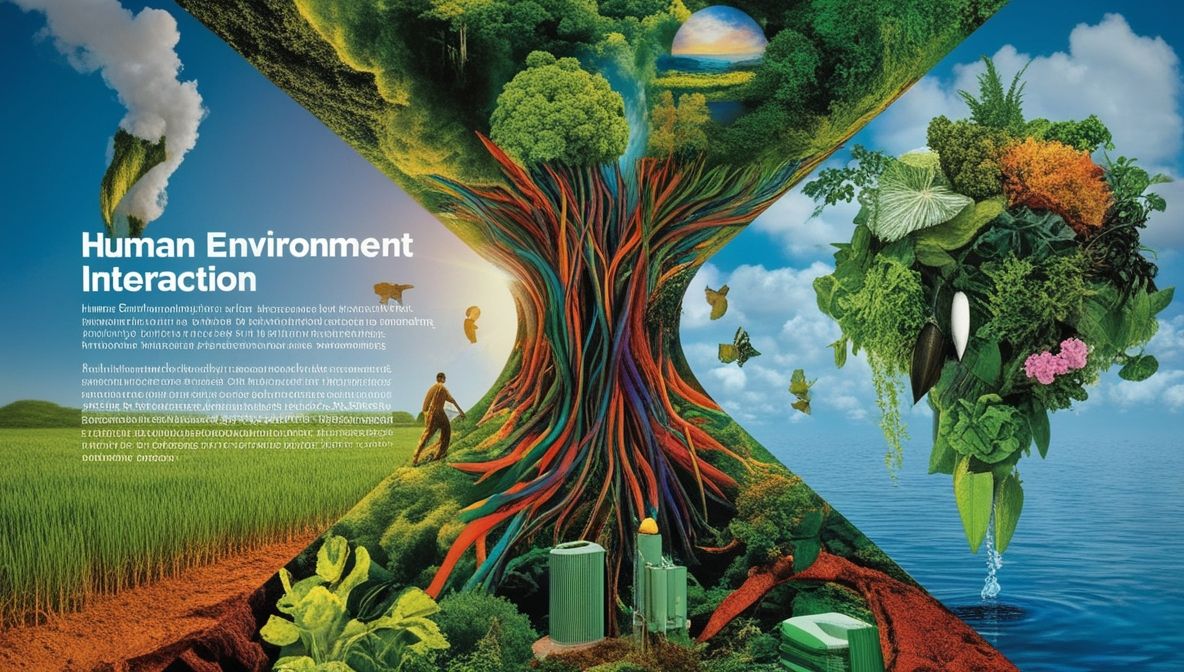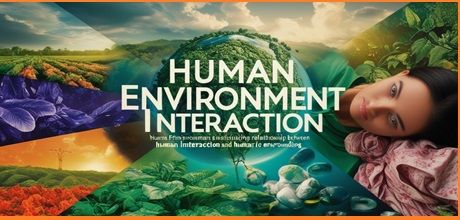Introduction
Human Environment Interaction refers to the dynamic relationship between humans and their natural surroundings. This interaction is multifaceted, encompassing how human activities impact the environment and how environmental changes, in turn, affect human societies. Understanding this relationship is crucial for addressing pressing global challenges such as climate change, resource depletion, and environmental degradation. This essay explores the various dimensions of human environment interaction, examining historical perspectives, contemporary issues, and potential pathways toward sustainable coexistence.
Historical Perspectives on Human Environment Interaction
Throughout history, human societies have adapted to and modified their environments to meet their needs. Early hunter-gatherer communities depended on their immediate surroundings for food, water, and shelter. As humans transitioned to agricultural societies, they began to alter landscapes more extensively, clearing forests for farmland and diverting rivers for irrigation. These activities enabled population growth and the development of complex civilizations but also led to significant environmental changes.

For example, the rise of agricultural societies around 10,000 years ago marked a profound shift in human-environment interaction. The domestication of plants and animals allowed for more stable food sources, which in turn supported larger, sedentary populations. However, these practices also led to deforestation, soil erosion, and biodiversity loss. The ancient Mesopotamian civilization, for instance, experienced soil salinization due to intensive irrigation, which ultimately contributed to its decline.
Industrialization and Environmental Impact
The Industrial Revolution, beginning in the late 18th century, dramatically intensified human impact on the environment. The shift from agrarian economies to industrialized societies brought about unprecedented levels of resource extraction, energy consumption, and pollution. Factories powered by coal and later by oil and gas transformed landscapes and released large quantities of greenhouse gases into the atmosphere.
Industrialization also spurred urbanization, leading to the growth of cities and increased demand for infrastructure and services. This urban expansion often came at the expense of natural habitats and agricultural land. For example, the rapid industrialization and urbanization of the United States in the 19th and 20th centuries resulted in widespread deforestation, wetland drainage, and air and water pollution.
Contemporary Issues in Human Environment Interaction
Today, human environment interaction is characterized by complex, interconnected challenges that require integrated solutions. Climate change, driven by anthropogenic greenhouse gas emissions, poses a significant threat to ecosystems and human societies. Rising temperatures, changing precipitation patterns, and more frequent extreme weather events disrupt agricultural productivity, water supply, and human health.
Deforestation, particularly in tropical regions, continues to be a major environmental issue. Forests play a critical role in regulating the climate, maintaining biodiversity, and providing livelihoods for millions of people. However, large-scale logging, agricultural expansion, and infrastructure development are leading to the loss of these vital ecosystems. The Amazon rainforest, often referred to as the “lungs of the Earth,” has seen significant deforestation in recent decades, threatening biodiversity and contributing to climate change.
Water scarcity is another pressing issue resulting from human environment interaction. Over-extraction of groundwater, pollution of freshwater sources, and climate-induced changes in water availability are creating water stress in many parts of the world. In regions like the Middle East and North Africa, water scarcity exacerbates social tensions and can lead to conflicts over access to this critical resource.

Human Adaptation and Resilience
Despite the challenges, human societies have shown remarkable adaptability and resilience in the face of environmental changes. Throughout history, communities have developed innovative strategies to cope with and mitigate the impacts of environmental stressors. For example, traditional agricultural practices such as terracing and crop rotation have helped prevent soil erosion and maintain soil fertility in various parts of the world.
In contemporary times, technological advancements and scientific research offer new opportunities for addressing environmental challenges. Renewable energy sources such as solar, wind, and hydroelectric power are becoming increasingly viable alternatives to fossil fuels, reducing greenhouse gas emissions and mitigating climate change. Innovations in water management, such as desalination and water recycling, are helping to alleviate water scarcity in arid regions.
Urban planning and green infrastructure are also playing a crucial role in enhancing the sustainability and resilience of cities. Green roofs, urban forests, and permeable pavements help manage stormwater, reduce urban heat islands, and improve air quality. Cities like Copenhagen and Singapore are leading examples of how integrated urban planning can create more livable and sustainable environments.

Pathways to Sustainable Human Environment Interaction
Achieving sustainable human environment interaction requires a holistic approach that integrates environmental, social, and economic dimensions. Key strategies include:
- Sustainable Resource Management: Implementing practices that ensure the long-term availability of natural resources is essential. This involves adopting sustainable agricultural methods, responsible forestry practices, and efficient water use.
- Climate Change Mitigation and Adaptation: Reducing greenhouse gas emissions through the transition to renewable energy, energy efficiency, and reforestation is crucial. Additionally, adapting to climate impacts by enhancing infrastructure resilience and developing early warning systems can help communities better cope with climate-related risks.
- Biodiversity Conservation: Protecting and restoring ecosystems and biodiversity is vital for maintaining the health and stability of the planet. Establishing protected areas, promoting sustainable land use, and supporting conservation initiatives can help preserve critical habitats and species.
- Environmental Education and Awareness: Raising awareness and promoting environmental education is essential for fostering a culture of sustainability. Educating individuals and communities about the importance of environmental stewardship and sustainable practices can drive positive change.
- Policy and Governance: Effective policies and governance frameworks are necessary to guide and enforce sustainable practices. Governments, businesses, and civil society must work together to create and implement regulations, incentives, and initiatives that support environmental sustainability.
- Community Engagement and Empowerment: Involving local communities in environmental decision-making processes and empowering them to take action is crucial. Community-based approaches to conservation and resource management can lead to more effective and sustainable outcomes.
Conclusion
Human environment interaction is a complex and dynamic relationship that has shaped the course of human history and continues to influence our present and future. By understanding the historical context, recognizing contemporary challenges, and adopting sustainable practices, we can foster a more harmonious and sustainable relationship with our environment. Through collective efforts and innovative solutions, it is possible to address the pressing environmental challenges of our time and create a more sustainable future for all.

antmk7
x8lhqi
Excellent post. I was checking continuously this blog and I’m impressed! Very helpful information specifically the last part 🙂 I care for such information a lot. I was looking for this certain information for a long time. Thank you and best of luck.
lqanu0
Looking for the latest 1xBet promo code to unlock exclusive bonuses and free bets? Whether you’re in Bangladesh, Pakistan, India, Nepal, Sri Lanka, Philippines, Egypt, or Nigeria, we’ve got the best 1xBet promo codes today just for you. Use a 1xBet promo code for registration to get started with a welcome bonus, free spins, or a no deposit bonus. Daily updated codes ensure you never miss out—get your 1xBet Bangladesh promo code, Pakistan free bet promo code, or India promo code for 1xBet app right here. Don’t wait—grab your 1xBet official promo code today and start winning big! No matter where you are, finding the right 1xBet promo code today means unlocking bigger chances to win, with offers perfectly tailored for players across Bangladesh, Pakistan, India, Nepal, Sri Lanka, Nigeria, Egypt, and the Philippines.
Wake up your way with this premium CD player alarm clock radio. Whether you prefer to rise with the AM/FM radio, your favorite CD, or a standard buzzer, this versatile alarm clock with CD player has you covered. Its intuitive design includes dual alarms, a large digital display, snooze/sleep timers, and USB charging for your phone. Enjoy high-quality stereo sound from a compact unit that fits easily on any bedside table or shelf. The best clock radios with CD player combine retro functionality with modern convenience—and this one leads the pack.
Wake up your way with this premium CD player alarm clock radio. Whether you prefer to rise with the AM/FM radio, your favorite CD, or a standard buzzer, this versatile alarm clock with CD player has you covered. Its intuitive design includes dual alarms, a large digital display, snooze/sleep timers, and USB charging for your phone. Enjoy high-quality stereo sound from a compact unit that fits easily on any bedside table or shelf. The best clock radios with CD player combine retro functionality with modern convenience—and this one leads the pack.
I enjoy your writing style genuinely loving this website .
Great web site. A lot of helpful info here. I’m sending it to several buddies ans additionally sharing in delicious. And obviously, thank you for your effort!
I like this web blog very much so much fantastic information.
Loving the information on this internet site, you have done outstanding job on the posts.
A lot of thanks for your whole work on this website. Debby loves doing internet research and it’s simple to grasp why. Many of us learn all regarding the compelling manner you convey important steps via your web site and as well attract participation from some other people about this article so my princess is now becoming educated a lot of things. Enjoy the rest of the year. You’re the one conducting a remarkable job.
Excellent blog here! Also your website lots up very fast! What web host are you the usage of? Can I am getting your affiliate link for your host? I want my web site loaded up as fast as yours lol
Wow that was odd. I just wrote an extremely long comment but after I clicked submit my comment didn’t show up. Grrrr… well I’m not writing all that over again. Anyways, just wanted to say fantastic blog!
Some genuinely superb posts on this website , thanks for contribution.
I genuinely enjoy reading on this web site, it has superb articles. “Beware lest in your anxiety to avoid war you obtain a master.” by Demosthenes.
Good day very cool site!! Guy .. Beautiful .. Superb .. I’ll bookmark your website and take the feeds additionallyKI am happy to search out numerous useful info here within the publish, we want develop extra strategies in this regard, thanks for sharing. . . . . .
Appreciate it for helping out, wonderful info .
I am writing to make you understand what a terrific encounter my wife’s child undergone browsing your webblog. She picked up plenty of pieces, which include how it is like to have a wonderful helping style to have many people smoothly comprehend several impossible subject areas. You really did more than my desires. Thanks for producing these informative, healthy, informative and even unique tips on that topic to Lizeth.
Well I truly enjoyed studying it. This tip offered by you is very constructive for correct planning.
Great write-up, I’m normal visitor of one’s web site, maintain up the nice operate, and It is going to be a regular visitor for a long time.